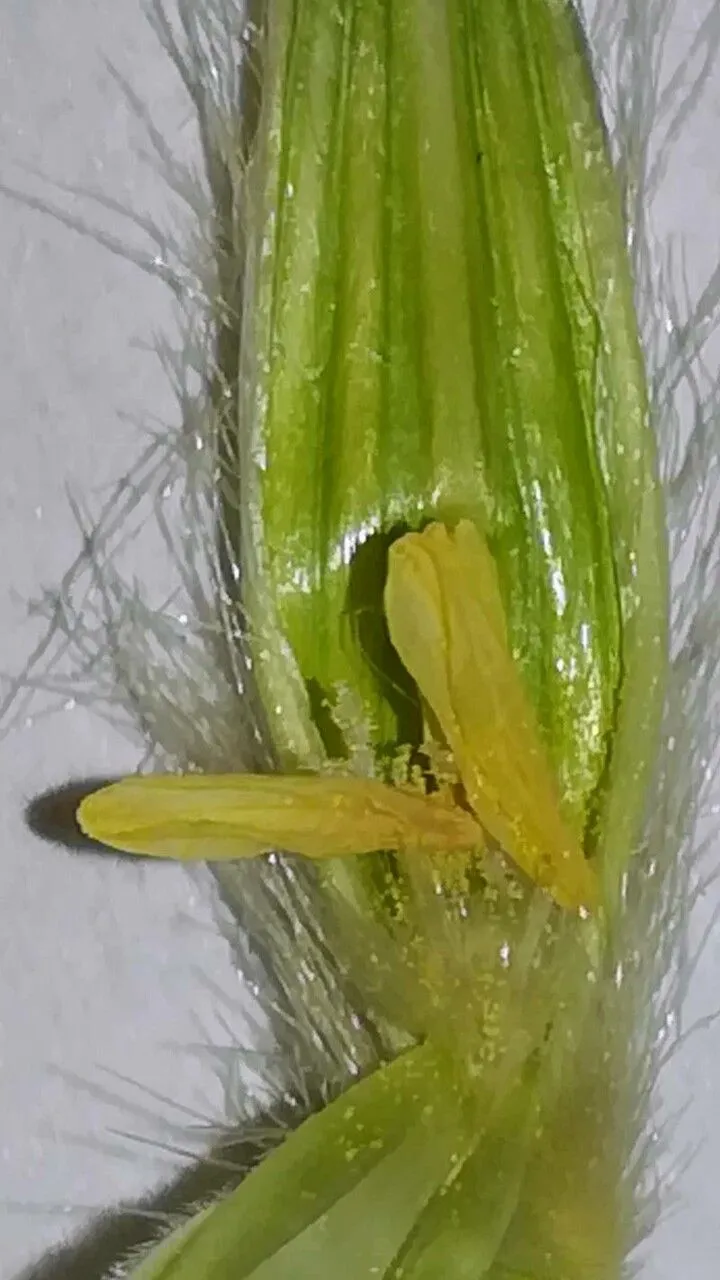
Author: L.
Bibliography: Sp. Pl. ed. 2.: 118 (1762)
Year: 1762
Status: accepted
Rank: species
Genus: Avena
Vegetable: Unknown
Observations: Canary Is., Medit. to W. Himalaya and Kenya
Sterile oat (Avena sterilis) is a notable grass species belonging to the Poaceae family. First identified and classified by the renowned botanist Carl Linnaeus in his seminal work “Species Plantarum” (2nd edition, 1762), this plant has drawn scientific interest due to its unique characteristics and wide geographic distribution.
Sterile oat is prevalent in an extensive range from the Canary Islands and across the Mediterranean to the western Himalayas and even reaching Kenya. This wide distribution showcases the plant’s adaptability to diverse climates and soils, contributing to both its ecological significance and its agricultural relevance.
The name “sterile oat” hints at one of its key biological traits. Unlike other oat species that are cultivated for grain production, Avena sterilis does not produce viable seeds in a form suitable for widespread agricultural use. However, this doesn’t reduce its value within its native ecosystems. It often presents itself as a robust and resilient species, able to thrive in environments where other plants might struggle, thus playing an integral role in those habitats.
In terms of morphology, Avena sterilis resembles its cultivated relatives with slender, erect stems and narrow leaves. The spikelets of the plant are typically large and bristly, which can often be a distinguishing feature. These characteristics can also sometimes make it a weed in cultivated fields, where it competes with crops for light, nutrients, and water.
Ecologically, sterile oat participates in maintaining soil structure and preventing erosion, especially in regions where the vegetation cover is sparse. Its presence in the Canary Islands, Mediterranean region, and up to the semi-arid areas of the western Himalayas indicates its importance in those ecosystems, providing necessary ground cover and serving as a part of the food web.
Understanding the role and distribution of Avena sterilis can offer valuable insights into grassland ecology, invasive species management, and the evolutionary pathways of the Poaceae family. Despite being termed sterile, this versatile plant is intrinsically valuable to the environments it inhabits, demonstrating nature’s complexity and resilience.
Eng: animated oat, winter wild-oat, sterile oat, wild oat, wild red oat, winter wild oat, animated oats
Dan: gold havre
Deu: taub-hafer, tauber hafer, winterhafer
Por: aveia-estéril, aveão
Spa: avena caballuna, avena estéril, avena loca
Fra: avoine animée, avoine stérile, avoine sauvage, folle-avoine d’hiver
Ces: oves jalový
Swe: storhavre
Nld: wilde haver
Cym: ceirchen wyllt y gaeaf, ceirchwellt gwyllt yr hydref
En: Sterile oat, Animated oat, Winter wild oat, Wild oat, Wild red oat, Winter Wild-oat, Animated oats
Af: Groot wildehawer
Ar: خفور (خَفُور), زمير (زُميِّر), فاخور
Ca: Cugula, Cugula grossa
Zh: 长颖燕麦
Cs: Oves jalový
Da: Gold havre
Nl: Wilde haver
Et: Viljatu kaer
Fi: Korukaura
Fr: Avoine animée, Avoine stérile, Avoine sauvage, Folle-avoine d’hiver, Avoine à grosses graines
De: Winterhafer, Tauber Hafer, Taub-Hafer, Wild-Hafer, Wilder Rothafer
He: שיבולת-שועל נפוצה
It: Avena maggiore
Pt: Aveão, Aveia-estéril
Ru: Oves besplodny, Oves sredizemnomorskij
Es: Avena caballuna, Avena estéril, Avena loca
Sv: Storhavre
Zh-tw: 不实野燕麥
Ta: காட்டுக் காடைக்கண்ணி
Uk: Овес неплідний
Cy: Ceirchen wyllt y gaeaf, Ceirchwellt Gwyllt yr Hydref
Fy: Oat
Taken May 3, 2019 by ruiz mar (cc-by-sa)
Taken Apr 27, 2022 by Gianni Del Bufalo (cc-by-sa)
Taken Apr 27, 2022 by Gianni Del Bufalo (cc-by-sa)
Taken Apr 27, 2022 by Gianni Del Bufalo (cc-by-sa)
Taken Apr 27, 2022 by Gianni Del Bufalo (cc-by-sa)
Taken Apr 14, 2021 by Lopez (cc-by-sa)
Taken Jun 8, 2022 by Anja Fox (cc-by-sa)
Taken Apr 14, 2021 by Lopez (cc-by-sa)
Taken May 22, 2022 by Jose Gisbert (cc-by-sa)
Taken Jun 14, 2014 by Tela Botanica − Paul FABRE (cc-by-sa)
Taken Jul 1, 2019 by t f (cc-by-sa)
Taken Jun 5, 2019 by Eva Maria (cc-by-sa)
Taken Jan 29, 2021 by Lezaun Juan Antonio (cc-by-sa)
Taken Jun 16, 2018 by francois tissot (cc-by-sa)
Taken Jun 20, 2022 by Steve De Repentigny (cc-by-sa)
Taken May 15, 2022 by Maarten Vanhove (cc-by-sa)
© copyright of the Board of Trustees of the Royal Botanic Gardens, Kew.
© copyright of the Board of Trustees of the Royal Botanic Gardens, Kew.
© copyright of the Board of Trustees of the Royal Botanic Gardens, Kew.
Taken May 29, 2004 by Tela Botanica − Augustin ROCHE (cc-by-sa)
Taken Apr 30, 2013 by Tela Botanica − Geneviève Botti (cc-by-sa)
Taken Jun 14, 2014 by Tela Botanica − Paul FABRE (cc-by-sa)
Taken Jun 14, 2014 by Tela Botanica − Paul FABRE (cc-by-sa)
Taken Jun 14, 2014 by Tela Botanica − Paul FABRE (cc-by-sa)
Taken Aug 15, 2019 by Photoflora – Benoit BOCK (©)
Taken May 9, 2012 by Tela Botanica − Liliane Roubaudi (cc-by-sa)
Taken May 29, 2004 by Tela Botanica − Augustin ROCHE (cc-by-sa)
Taken May 29, 2004 by Tela Botanica − Augustin ROCHE (cc-by-sa)
Taken May 29, 2004 by Tela Botanica − Augustin ROCHE (cc-by-sa)
Family: Myrtaceae Author: (F.Muell.) K.D.Hill & L.A.S.Johnson Bibliography: Telopea 6: 402 (1995) Year: 1995 Status:…
Family: Rubiaceae Author: Pierre ex A.Froehner Bibliography: Notizbl. Bot. Gart. Berlin-Dahlem 1: 237 (1897) Year:…
Family: Sapindaceae Author: Koidz. Bibliography: J. Coll. Sci. Imp. Univ. Tokyo 32(1): 38 (1911) Year:…
Family: Asteraceae Author: A.Gray Bibliography: Pacif. Railr. Rep.: 107 (1857) Year: 1857 Status: accepted Rank:…
Family: Fabaceae Author: Medik. Bibliography: Vorles. Churpfälz. Phys.-Ökon. Ges. 2: 398 (1787) Year: 1787 Status:…
Family: Aspleniaceae Author: (Cav.) Alston Bibliography: Bull. Misc. Inform. Kew 1932: 309 (1932) Year: 1932…